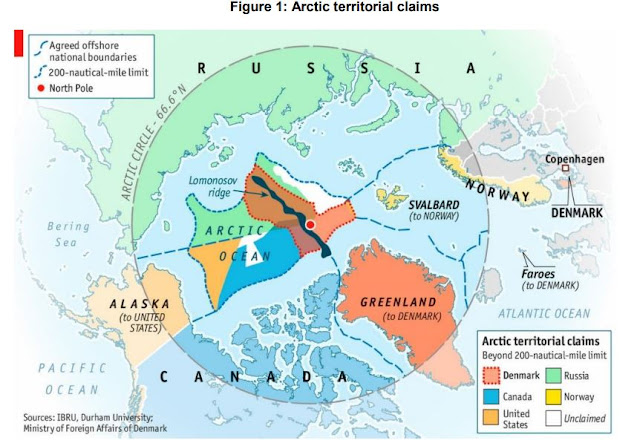Before the Russo-Ukrainian War kicked off in February, on the Top-5 lists of any navalist worth their salt was the Arctic. If you are an Atlanticist/NATO type, it was in your Top-3.
Sea lanes/SLOC, resource access, resource protection, environmental protection and monitoring, and just good old sound military planning kept the Arctic on everyone’s mind. The fact that especially in the USA there was no small bit of “out of sight out of mind” neglect, specifically with our icebreaking capabilities, brought as much concern. The non-Arctic nation of China deciding she wanted to be a player only made it even more important that policy makers wake up.
When you look at the playing board in the Arctic, the nations who have square-footage in the game are the USA, Iceland, Denmark, Norway, Canada, and Russia. You can even throw in the island nation of the United Kingdom as she is the dominate North Atlantic power outside the USA and any problem north of her can get existential real fast.
Note the outlier in this list? Yes, Russia.
As we find ourselves in the fall of 2022, we have an opportunity here that may not come again for a long time. It is right in front of us. It won’t take much effort; we just need to step up and take advantage of it.
Yes, I said “advantage.” The NATO nations of USA/GBR/ICL/DNK/NOR/CAN have to tap into their opportunistic brain stem and make up for lost time. Russia is on her back foot in Ukraine. For the foreseeable future, her efforts, money and resources that may have been headed to the Arctic will be diverted towards the Black Sea instead.
We dropped the ball so far this century in the Arctic – now is the time, with just a little effort – to make up for that oversight;
As Russia's invasion of Ukraine ends a post-Cold War era of low tension and cooperation, such events highlight how hard it is for states to monitor their own waters – particularly in the Arctic, an ocean one and a half times the size of the United States, where satellites are crucial to allow real-time detection and monitoring of activity.
Over recent years, NATO allies and Russia have scaled up military exercises in the region; Chinese and Russian warships conducted a joint exercise in the Bering Sea in September. Norway raised its military alert level in October.
But the West trails Russia in military presence.
Since 2005, Russia has reopened tens of Arctic Soviet-era military bases, modernised its navy, and developed new hypersonic missiles designed to evade U.S. sensors and defences.
Four Arctic experts say it would take the West at least 10 years to catch up with Russia's military in the region, if it chose to do so.
"The Arctic is currently a dark area on the map," said Ketil Olsen, formerly Norway's military representative in NATO and the European Union, who heads Andoeya Space, a Norwegian state-controlled company that tests new military and surveillance technologies and launches research rockets.
"It's so vast and with few civilian surveillance resources."
The chief of the U.S. Northern Command, General Glen VanHerck, told a Senate hearing in March the United States needed better Arctic "domain awareness" to detect and address Russian and Chinese capabilities to launch advanced missiles and destroy communications infrastructure. In a Pentagon strategy document released in October, the United States committed to improving early warning and surveillance systems in the Arctic, but the pace of the planned modernisation is unclear.
...
The waters between Greenland, Iceland and the UK - known as the GIUK Gap - are the only way Russia's northern-based ships can reach the Atlantic. The shortest path by air to North America for Russian missiles or bombers would be over the North Pole.
For the NATO allies, the GIUK Gap is crucial for links across the North Atlantic. There are oil and gas fields too: Norway is now Europe's largest gas supplier.
If Sweden and Finland join the Alliance, seven out of eight Arctic countries will be members.
Also at risk today are communications cables and satellite systems including the global positioning system (GPS) linking both civilian and military users, Andrew Lewis, former commander of NATO's Joint Task Force in Norfolk, Virginia, told Reuters.
In July, President Vladimir Putin launched a new naval strategy pledging to protect Arctic waters "by all means."
...
More answers may come in a stand-alone Arctic strategy document the Pentagon is expected to publish next March, a U.S. military official said, in what would be the first update since 2019. It would come as the Pentagon tries to better define what capabilities are needed for American warfighters at dangerously low temperatures.
"When it's dark all the time in the winter and it's 50- to 60-below-zero or even more, it is just brutal," the official told Reuters.
We need to act in our individual and collective interest. There is a rare opportunity here for our policy makers. Yes, they are busy, but they need to find the spare capacity to invest some effort that will accrue huge benefits. As mentioned in the article, with Sweden and Finland joining NATO, there will be even more reasons to get our act together in the high north.
We don't need to wait for a March 2023 document. Our NATO allies especially don't. No time is better than the present.
Now.
As usual, our friend Jerry Hendrix was ahead of the curve. If you need a modern perspective on the importance of the GIUK Gap mentioned in the pull quote, Jerry co-authored a report five years ago that remains one of the best resources on the topic out there.

No comments:
Post a Comment